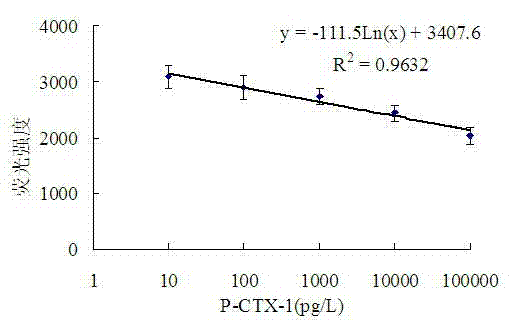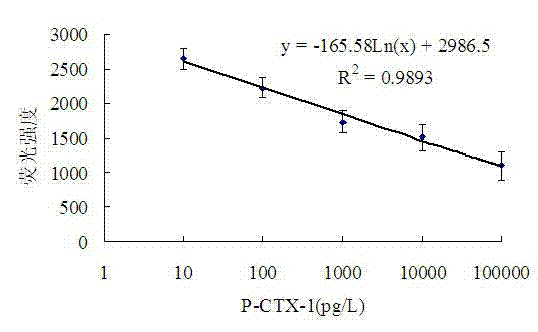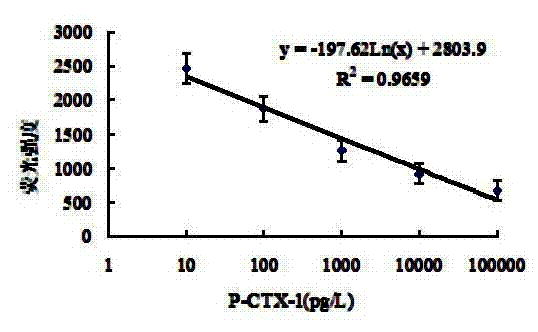Sodium fluorescence probe detection method of ciguatoxin
A fluorescent probe and sodium ion technology, applied in fluorescence/phosphorescence, microbial measurement/inspection, biochemical equipment and methods, etc., can solve problems such as low sensitivity, low specificity, and easy interference of detection results, and achieve Sensitive detection, strong specific effect
- Summary
- Abstract
- Description
- Claims
- Application Information
AI Technical Summary
Problems solved by technology
Method used
Image
Examples
Embodiment 1
[0021] Example 1: Detection of ciguatoxin by sodium ion fluorescent probe detection method.
[0022] Cultivate mouse brain neuroma cells (N-2a), wait until the cells grow to 80-90% confluence, digest and collect the cells with 0.25% trypsin-EDTA, centrifuge and remove the supernatant, add RPMI-1640 medium to resuspend cells to a density of 3 x 10 5 cells / mL, inoculate 100 μL of cell suspension in a 96-well black plate, place at 37°C and 5% CO 2 Cultured in a saturated humidity cell incubator. After culturing for 24 h, discard the medium, wash with PBS 2-3 times, add 90 μL ouabain solution and 10 μL ciguatoxin standard (P-CTX-1) to each well of the experimental group. The concentration gradient is 1~10 7 pg / L, a solvent control group and a blank control group were set, and three parallels were set for each test group. After 12 h of exposure, the medium was discarded, and 100 μL of sodium ion fluorescent probe CoroNa at a concentration of 5 μmol / L was added. TM Green stai...
Embodiment 2
[0024] Example 2: Detection of ciguatoxin by sodium ion fluorescent probe detection method.
[0025] Cultivate mouse brain neuroma cells (N-2a), wait until the cells grow to 80-90% confluence, digest and collect the cells with 0.25% trypsin-EDTA, centrifuge and remove the supernatant, add RPMI-1640 medium to resuspend cells to a density of 3 x 10 5 cells / mL, inoculate 100 μL of cell suspension in a 96-well black plate, place at 37°C and 5% CO 2 Cultured in a saturated humidity cell incubator. After culturing for 24 h, discard the medium, wash with PBS 2-3 times, add 90 μL ouabain solution and 10 μL ciguatoxin standard (P-CTX-1) to each well of the experimental group. The concentration gradient is 1~10 7 pg / L, a solvent control group and a blank control group were set, and three parallels were set for each test group. After 18 h of exposure, the medium was discarded, and 100 μL of sodium ion fluorescent probe CoroNa at a concentration of 5 μmol / L was added. TM Green stai...
Embodiment 3
[0027] Example 3: Detection of ciguatoxin by sodium ion fluorescent probe detection method.
[0028] Cultivate mouse brain neuroma cells (N-2a), wait until the cells grow to 80-90% confluence, digest and collect the cells with 0.25% trypsin-EDTA, centrifuge and remove the supernatant, add RPMI-1640 medium to resuspend cells to a density of 3 x 10 5 cells / mL, inoculate 100 μL of cell suspension in a 96-well black plate, place at 37°C and 5% CO 2 Cultured in a saturated humidity cell incubator. After culturing for 24 h, discard the medium, wash with PBS 2-3 times, add 90 μL ouabain solution and 10 μL ciguatoxin standard (P-CTX-1) to each well of the experimental group. The concentration gradient is 1~10 7 pg / L, a solvent control group and a blank control group were set, and three parallels were set for each test group. After 24 h of exposure, the medium was discarded, and 100 μL of sodium ion fluorescent probe CoroNa at a concentration of 5 μmol / L was added. TM Green stai...
PUM
 Login to View More
Login to View More Abstract
Description
Claims
Application Information
 Login to View More
Login to View More - R&D
- Intellectual Property
- Life Sciences
- Materials
- Tech Scout
- Unparalleled Data Quality
- Higher Quality Content
- 60% Fewer Hallucinations
Browse by: Latest US Patents, China's latest patents, Technical Efficacy Thesaurus, Application Domain, Technology Topic, Popular Technical Reports.
© 2025 PatSnap. All rights reserved.Legal|Privacy policy|Modern Slavery Act Transparency Statement|Sitemap|About US| Contact US: help@patsnap.com



